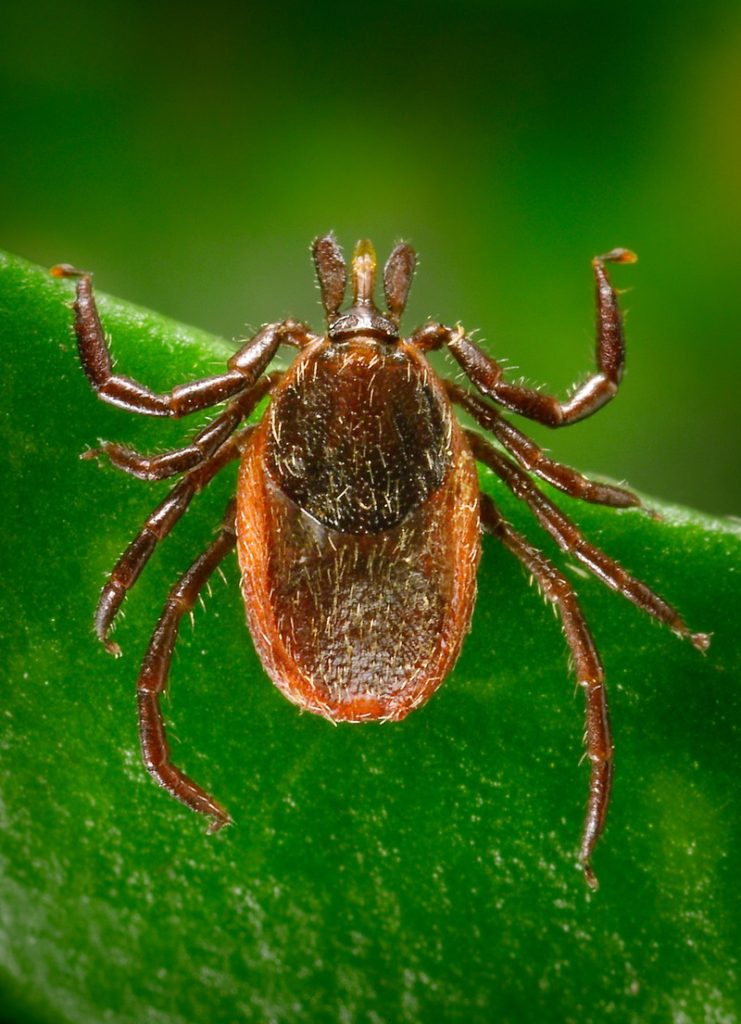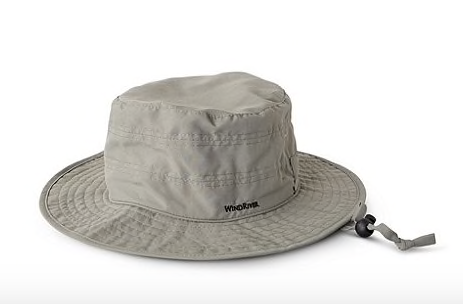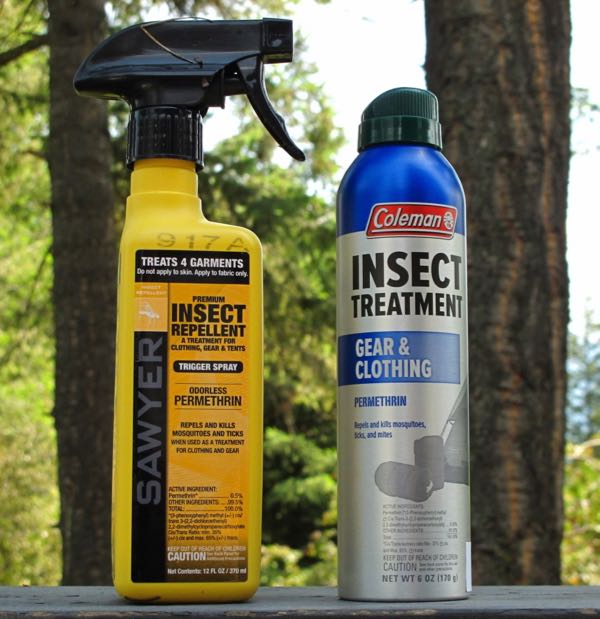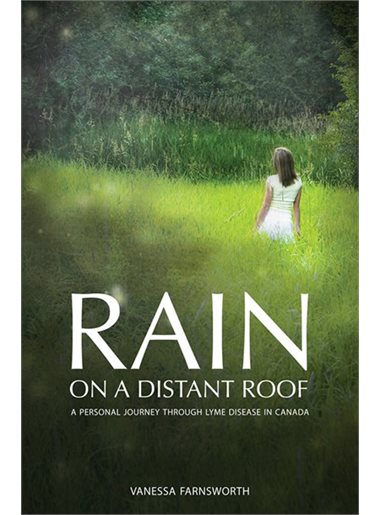
Western black-legged ticks (Ixodes pacificus) are potential carriers of Lyme disease in western Canada. Permethrin-treated clothing can be an effective barrier against ticks, mosquitoes and other bothersome insects, but the clothing has been difficult to purchase in Canada. Centres for Disease Control and Prevention (CDC) photo.
After years of frustration, Canadians are now able to purchase clothing that is commercially treated to protect against mosquitoes and ticks and the diseases they can carry.
Using “No Fly Zone by Burlington” technology, Marks (aka Marks Work Wearhouse) released a line of men’s and women’s clothing under its Wind River label in May. Shirts, pants, jackets and hats produced with permethrin-treated cloth are now available in major Marks outlets and online at Marks.com.
Similar clothing manufactured with the insecticide permethrin has been available in the rest of the world for years.
I originally addressed this issue in “Ticks, Permethrin and Canadian Hypocrisy” (April 2017). As mentioned in that posting, permethrin-treated clothing and spray for self-treatment of clothing has proved to be very effective in stunning and repelling a wide variety of insects and ticks.
But the Canadian Pest Management Regulatory Agency (CPMA) has been reluctant to approve these products, even though Health Canada recommends that people purchase permethrin-treated clothing when travelling into areas of the world where insect-transmitted diseases are common.
My original blog has since gone viral, and I receive comments daily from people throughout Canada, particularly those concerned about the spread of Lyme disease. Hopefully, some of their fears will be put to rest by the availability of No Fly Zone attire.
The Marks experience
When Marks announced it was releasing a line of permethrin-treated clothing, I contacted head office and arranged an interview with an executive who has been dealing with the issue for sometime. He described some of the hoops the company had to jump through on the road to approval.
Every company that wants to market permethrin-treated clothing in Canada must make a separate application to the CPMA. And even though permethrin-infused attire has undergone rigorous testing and been approved by the U.S. Environmental Protection Agency (EPA), and in nearly every country other country in the western world, the CPMA demands rigorous product testing and imposes stringent requirements.
According to my source, Marks worked with the CPMA for a decade to secure approval for its No Fly Zone clothing in Canada. Each time they thought they had answered all the questions about product safety, the CPMA moved the bar higher.
When Marks did finally receive approval, it was stipulated that all clothing and headwear be produced with a lining, a second layer acting as a barrier between the permethrin-treated cloth and the wearer. It is an added cost that producers in the rest of the world do not incur.

Wind River No Fly Zone Outback Hat
No Fly Zone by Burlington
Marks worked with Burlington Fabrics (Greensboro, North Carolina) to produce its line of attire. Under its No Fly Zone label, Burlington produces permethrin-treated material for a number of U.S. outdoor suppliers, including LL Bean, Stetson, Cabela’s, Solstice and Farm to Feet.
While Marks is not allowed to advertise that its clothing is effective against ticks, Burlington suffers no such restriction in the U.S. The company’s No Fly Zone Insect Repellency web page explains all aspects of the process and how an insect’s nervous system is affected upon contact with treated fabric.
Further support comes from a recent study published in the Journal of Medical Entomology (May 24, 2018) and summarized in a report by CBS News “Study confirms this method of repelling ticks really does work”.
Personal experience
Through several decades and thousands of kilometres of hiking in the Canadian Rockies, I’ve experienced good years and bad years when it comes to bugs, particularly mosquitoes.
And every spring is a bad spring when it comes to wood ticks on south-facing slopes (I always need to shake hitchhiking ticks from my clothing, and once I went to the hospital to have a nurse remove one that attached itself to my back.)
I was always reluctant to use DEET products unless conditions were really bad. After years of getting bitten, you develop an immunity to swelling and itching, but not to mosquitoes flying in your face and the sensation of their pin-pricks.
That’s why a few years ago, I started experimenting with permethrin-treated clothing—purchased in the U.S. or ordered from the UK and Europe (UK and EU firms were willing to ship treated attire to Canada, unlike U.S. outfitters who were constrained by Canadian restrictions). I’ve used Bugsaway (Ex Officio), Insect Shield (Outdoor Research and Buff) and Nosilife (Craghoppers). All use similar permethrin-treated fabrics, and I’ve found all to be equally effective.
Now I’m looking forward to testing No Fly Zone from Marks.

Permethrin sprays for clothing treatment are readily available in the U.S., but nowhere to be found in Canada. It is still possible for travellers to purchase these products in the U.S. and bring them back into Canada. Brian Patton photo.
Permethrin spray for treating clothing
Many outdoors people, especially hunters, swear by permethrin spray specifically designed for treating clothing. Of course, most of these enthusiasts are in the U.S.
If you want to self-treat your clothing with permethrin in Canada, you’ll have to purchase it in the States. Permethrin spray could be ordered online for shipment from the U.S. to Canadian addresses a year or so ago, but not today. Though I’ve not seen any documentation, it appears the PMRA is trying to stem the flow of permethrin spray into Canada.
But Canadians are a creative lot. UltraShield EX Insecticide & Repellent is sold as a fly spray for horses in Canadian agricultural outlets (0.50% Permethrin). Then there is The Protector House & Garden Liquid Insect Spray (and similar brands), also available in Canada, which contains 1.25% permethrin as the active ingredient. Desperate Canadians are purchasing these products to treat their clothing.
This is all rather ridiculous when you consider that sprays manufactured specifically for clothing should be a safer and more effective alternative than products manufactured for application to horses and garden plants.
I have used permethrin clothing sprays purchased in the U.S. However, as a hiker, I find it an expensive and fussy alternative to commercially-treated clothing since you need to repeat the treatment every six weeks or so and take care with how treated items are laundered and stored. I do keep a couple cans handy for spraying hats, socks and pant legs.
On the other hand, American hunters find spray quite useful since they can apply it to their hunting clothes and don’t have to worry about the application lasting longer than a few weeks. And there’s no better source of testimonials than these sportsmen. After years of crawling through the bush and grass, they report that they no longer return home covered with ticks like they did before permethrin spray came along.
Lyme disease
Black-legged ticks and their potential to spread Lyme disease is an issue that affects not only hikers, but anyone who spends time outdoors.
While I have no personal experience with Lyme, nearly everyone where I live in southern B.C. knows someone who has been treated for the disease, or worse, weren’t diagnosed early and now suffer with the chronic form.
I have a brother-in-law who contracted the disease in B.C.’s Lower Mainland, and has dealt with its devastating consequences for over a decade. (He gave up on Canada’s inadequate medical treatment for chronic Lyme disease long ago.)

Author Vanessa Farnsworth describes her nightmarish struggle with Lyme disease acquired in British Columbia’s East Kootenays in Rain on a Distant Roof: A Personal Journey Through Lyme Disease in Canada.
Most of the comments to my original blog have come from concerned citizens in the Maritimes and Ontario, regions where Lyme is most often found in Canada. These respondents all suffer the same frustrations, trying to acquire protection for themselves and their children when they’re out in the woods.
Canadians are justifiably concerned about tick and mosquito transmitted diseases and are willing to go to great lengths to protect themselves (horse fly spray and ant repellent?).
I can understand that Canada’s Pest Management Regulatory Agency doesn’t want to encourage a false sense of security regarding disease protection. The PMRA is being careful and fastidious when it comes to approval of insecticide for use by the general public, but the agency should be willing to approve products that have a proven record of safety and effectiveness everywhere else in the world.
In the meantime, I am encouraged that Marks is continuing to work with the PMRA in its efforts to develop permethrin-treated products. Canadians now have a home-grown option for protection.

Hi! Thanks for the update, I wish i read it before all the other webpages 😉 I purchased NoBu.gs clothing in their kickstarter campain and they are now well settle with their website, all purchases accessible to Canada, and I’m really satisfied. I still am looking for the spray to do more clothing for my entire family at a cheaper price. Thank you again for your researches and updates
Hi Brian, are the clothes at Marks just as good as the ones in the states? At least in regard to keeping ticks off? Same Permethrin percentage? Thanks for your great articles!
Marks’ WindRiver clothing uses technology developed by U.S.-based Burlington Fabrics for its No Fly Zone trademark. Check out the “No Fly Zone Insect Repellency” link under No Fly Zone by Burlington in my posting above, which provides a very thorough description of the technology and how it works. Burlington also produces No Fly Zone fabric for LL Bean and Cabela’s in the U.S., so I suggest you check out “No Fly Zone” on llbean.com and cabelas.com (not cabelas.ca). You can read reviews on these websites from people who have used this clothing and also compare prices with Marks. (I find Marks far more competitive price-wise than LL Bean and Cabelas, especially if you take advantage of the company’s frequent sales.)
While Marks is prohibited from advertising No Fly Zone effectiveness against ticks, I can’t see why it shouldn’t provide a high degree of protection (there’s no 100% guarantee with any repellent). A recent study, published in the Journal of Medical Entomology (Oxford University Press, 24 May 2018), subjected several species of ticks to permethrin-treated clothing, which “resulted in all ticks being unable to move normally, thus posing no more than minimal risk of biting.”
With the exception of a WindRiver No Fly Zone ball cap, I haven’t had a chance to test other Marks permethrin-treated clothing. Because the Canadian PMRA requires a lining for all Marks treated clothing, I suspect shirts and pants might be warmer than U.S. and UK brands that I’ve worn over the past couple years (though I have no problem with the WindRiver ball cap). I hope to have a full report on the Marks No Fly Zone line later this summer.
Hi Brian,
Any update on how the boarder agency is treating travellers brings Sawyer spray back across the boarder? Flying to the states this month and was hoping to bring some back. Concerned it will get confiscated at the airport…
Permethrin spray for treating clothing has never been illegal in Canada. People bring it though land-entry border crossings all the time. However, the PMRA has blocked commercial shipments from the U.S.over the past year or two. If you’re flying, simply pack the product in your checked luggage, and there should be no problem. One caution: I wouldn’t purchase Sawyers in pressurized cans if you’re flying; get trigger spray dispensers.
Thanks Brian!
Hi Brian,
Thanks for your articles. Do you know if there’s stores other than Marks that sell permethrin treated clothing in Ontario, Canada? We’ve checked today in Cabelas Ottawa and they don’t have any. The ones in Marks do feel thick with the lining, specially the shirts. Thanks!
Marks is currently the only company allowed to sell permethrin-treated clothing in Canada. U.S. outlets, like Cabelas, REI, LL Bean, etc, aren’t allowed to ship permethrin product into the country. But you can purchase permethrin-treated clothing in the U.S. and bring it back into the country no problem. If you’re not travelling to the States and would still like unlined, insect-repellent clothing, you can purchase through amazon.ca at very competitive prices and with free shipping. (Don’t ask me why amazon can do what others can’t.) Check out ExOfficio BugsAway clothing on amazon.ca for a wide variety of attire with Insect Shield. My favourite for warm weather is the ExOfficio BugsAway Sandfly jacket (Damselfly women’s version). You can also order similar product by White Sierra and Solstice on amazon.ca, but I’m not familiar with these brands.
Thanks for the detailed info Brian!!! I will look that clothing company up on amazon.ca, since I don’t anticipate travelling to the States any time soon.
What about kids? Don’t they deserve some form of protection?
Does marks warehouse have kid sizes?
Yes, kids are a primary concern when it comes to Lyme disease. Marks permethrin-treated clothing is all that’s available in Canada, but it doesn’t sell kids clothing. And even if it did, Canada’s ultra-conservative Pest Management Regulatory Agency likely wouldn’t allow it.
There are a couple good sources for kids’ permethrin-treated clothing in the U.S. One line is Bug Smarties (available at U.S. Walmart https://www.walmart.com/search/?query=bug%20smarties). Insect Shield also provides an excellent selection of clothing specifically for children (https://www.insectshield.com/Shop.aspx). But neither company is allowed to ship this clothing into Canada.
If you are not up for a cross-border shopping trip, I can only suggest U.S.-based friends or family who could trans-ship product to you as a gift.
As for Canada’s PMRA, someone should tell them that permethrin-treated clothing for kids is far less toxic than slathering them with DEET.
I bought a shirt and pants from Marks. They’re too hot with the lining for the most part. Since other countries don’t require the lining, I’m going to cut the lining out. Other than that they’re great! I wear them gardening, hiking, cutting the grass, etc.
So in other words the “public service” bureaucrats keeping “raising the bar higher” as you put it, either to make work for themselves, or because they have been ordered to obstruct the process so Canadians won’t have access to have Permethrin as a liquid or on treated clothing. Anyone interested in the weirdness around Lyme Disease should watch the documentary “Under Our Skins”, for some idea of why Canadian agencies first pretend Lyme isn’t here, and then block the best defence against it. If they just wanted to reduce the reporting of Lyme they would allow Permethrin. Or is this a shakedown of companies that haven’t “invested” in the “right” Canadian province yet??
Is Permethrin safe for your health and if not what are the side effects ?
The U.S. Environmental Protection Agency (EPA) says that the amount of permethrin allowed in clothing is too low to pose risks to humans. However, there are health concerns when handling liquid permethrin (household sprays and livestock treatments). Check out safety of permethrin-treated clothing on the Environmental Working Group website (ewg.org).
Does the clothing lose it’s protection after being laundered?
All companies producing permethrin-treated clothing advertise that protection lasts for 70 washings. However, I have seen some reports that effectiveness starts falling off after 20 washings.
Just to let your readers know there is somewhere in Canada you can purchase permethrin https://thekoregarden.ca/product/garden-protector-spray-insecticide/
Kore Garden appears to be an effective product for repelling home and garden pests. However, it is not designed for clothing applications and not recommended for that purpose.
Thanks for this article which I came across shortly after being bitten by mosquitoes while gardening. Are there any updates? I see in the USA you can send off your clothing to be treated which would be ideal. Any advice about spraying the garden for mosquitoes. Services such as mosquito man are very expensive. Many thanks
Deena
Little has changed since I wrote this article. As a gardener, you might not mind the added warmth of Mark’s No Fly Zone clothing (permethrin treatment and double layer guarantees you won’t get bitten through the clothing). However, any exposed skin will require repellent—get Picaridin (aka Icaridin) instead of DEET, even though the latter still dominates the retail shelves. No, I don’t know of any broadcast spray for mosquitoes in the garden and I wouldn’t trust anyone who says they can cure the situation.